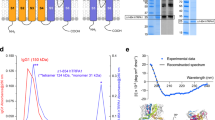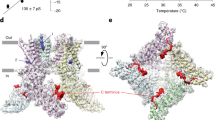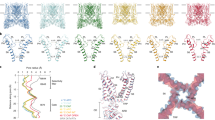Abstract
Transient receptor potential (TRP) proteins are cation-selective channels that function in processes as diverse as sensation and vasoregulation. Mammalian TRP channels that are gated by heat and capsaicin (>43 °C; TRPV1 (ref. 1)), noxious heat (>52 °C; TRPV2 (ref. 2)), and cooling (< 22 °C; TRPM8 (refs 3, 4)) have been cloned; however, little is known about the molecular determinants of temperature sensing in the range between ∼22 °C and 40 °C. Here we have identified a member of the vanilloid channel family, human TRPV3 (hTRPV3) that is expressed in skin, tongue, dorsal root ganglion, trigeminal ganglion, spinal cord and brain. Increasing temperature from 22 °C to 40 °C in mammalian cells transfected with hTRPV3 elevated intracellular calcium by activating a nonselective cationic conductance. As in published recordings from sensory neurons, the current was steeply dependent on temperature, sensitized with repeated heating, and displayed a marked hysteresis on heating and cooling5,6,7,8,9,10. On the basis of these properties, we propose that hTRPV3 is thermosensitive in the physiological range of temperatures between TRPM8 and TRPV1.
This is a preview of subscription content, access via your institution
Access options
Subscribe to this journal
Receive 51 print issues and online access
$199.00 per year
only $3.90 per issue
Buy this article
- Purchase on Springer Link
- Instant access to full article PDF
Prices may be subject to local taxes which are calculated during checkout





Similar content being viewed by others
Notes
* Figures 3e and 4d were published incorrectly in the AOP version of this paper on 23 June 2002. In the AOP publication, the blue trace in Fig. 3e was labelled incorrectly as 'NMDG+ (30 mM Ca2+)' and the red trace was labelled incorrectly as 'NMDG+ (0 mM Ca2+)'. Likewise, in Fig. 4d, the second trace from the top was incorrectly labelled as '+60 mV'. These errors were corrected on 11 July 2002.
References
Caterina, M. J. et al. The capsaicin receptor: a heat-activated ion channel in the pain pathway. Nature 389, 816–824 (1997)
Caterina, M. J., Rosen, T. A., Tominaga, M., Brake, A. J. & Julius, D. A capsaicin-receptor homologue with a high threshold for noxious heat. Nature 398, 436–441 (1999)
McKemy, D. D., Neuhausser, W. M. & Julius, D. Identification of a cold receptor reveals a general role for TRP channels in thermosensation. Nature 416, 52–58 (2002)
Peier, A. M. et al. A TRP channel that senses cold stimuli and menthol. Cell 108, 705–715 (2002)
Spray, D. C. Cutaneous temperature receptors. Annu. Rev. Physiol. 48, 625–638 (1986)
Reichling, D. B. & Levine, J. D. Heat transduction in rat sensory neurons by calcium-dependent activation of a cation channel. Proc. Natl Acad. Sci. USA 94, 7006–7011 (1997)
Gotoh, H., Akatsuka, H. & Suto, K. Warm cells revealed by microfluorimetry of Ca2+ in cultured dorsal root ganglion neurons. Brain Res. 796, 319–322 (1998)
Cesare, P., Moriondo, A., Vellani, V. & McNaughton, P. A. Ion channels gated by heat. Proc. Natl Acad. Sci. USA 96, 7658–7663 (1999)
Hori, A., Minato, K. & Kobayashi, S. Warming-activated channels of warm-sensitive neurons in rat hypothalamic slices. Neurosci. Lett. 275, 93–96 (1999)
Liu, L. & Simon, S. A. Capsaicin, acid and heat-evoked currents in rat trigeminal ganglion neurons; relationship to functional VR1 receptors. Physiol. Behav. 69, 363–378 (2000)
Brengelmann, G. L. in Textbook of Physiology Volume 2: Circulation, Respiration, Body Fluids, Metabolism, and Endocrinology (eds Patton, H. D., Fuchs, A. F., Hille, B., Scher, A. M. & Steiner, R.) 1584–1596, (W.B. Saunders, Philadelphia, 1989)
Hille, B. Ion Channels of Excitable Membranes (Sinauer Associates, Sunderland, Massachusetts, 2001)
Möller, S., Croning, M. D. & Apweiler, R. Evaluation of methods for the prediction of membrane spanning regions. Bioinformatics 17, 646–653 (2001)
Tominaga, M. et al. The cloned capsaicin receptor integrates multiple pain-producing stimuli. Neuron 21, 531–543 (1998)
Fundin, B. T., Rice, F. L., Pfaller, K. & Arvidsson, J. The innervation of the mystacial pad in the adult rat studied by anterograde transport of HRP conjugates. Exp. Brain Res. 99, 233–246 (1994)
Kanzaki, M. et al. Translocation of a calcium-permeable cation channel induced by insulin-like growth factor-1. Nature Cell. Biol. 1, 165–170 (1999)
Liedtke, W. et al. Vanilloid receptor-related osmotically activated channel (VR-OAC), a candidate vertebrate osmoreceptor. Cell 103, 525–535 (2000)
Strotmann, R., Harteneck, C., Nunnenmacher, K., Schultz, G. & Plant, T. D. OTRPC4, a nonselective cation channel that confers sensitivity to extracellular osmolarity. Nature Cell Biol. 2, 695–702 (2000)
Watanabe, H. et al. Activation of TRPV4 channels (hVRL-2/mTRP12) by phorbol derivatives. J. Biol. Chem. 4, 13569–13577 (2002)
Prakriya, M. & Lewis, R. S. Separation and characterization of currents through store-operated CRAC channels and Mg2+-inhibited cation (MIC) channels. J. Gen. Physiol. 119, 487–508 (2002)
Nadler, M. J. et al. LTRPC7 is a Mg·ATP-regulated divalent cation channel required for cell viability. Nature 411, 590–595 (2001)
Runnels, L. W., Yue, L. & Clapham, D. E. TRP-PLIK, a bifunctional protein with kinase and ion channel activities. Science 291, 1043–1047 (2001)
Jordt, S. E. & Julius, D. Molecular basis for species-specific sensitivity to ‘hot’ chili peppers. Cell 108, 421–430 (2002)
DeCoursey, T. E. & Cherny, V. V. Temperature dependence of voltage-gated H+ currents in human neutrophils, rat alveolar epithelial cells, and mammalian phagocytes. J. Gen. Physiol. 112, 503–522 (1998)
Davis, J. B. et al. Vanilloid receptor-1 is essential for inflammatory thermal hyperalgesia. Nature 405, 183–187 (2000)
Vyklicky, L. et al. Temperature coefficient of membrane currents induced by noxious heat in sensory neurones in the rat. J. Physiol. 517, 181–192 (1999)
Andrew, D. & Craig, A. D. Spinothalamic lamina I neurones selectively responsive to cutaneous warming in cats. J. Physiol. 537, 489–495 (2001)
Nagy, I. & Rang, H. P. Similarities and differences between the responses of rat sensory neurons to noxious heat and capsaicin. J. Neurosci. 19, 10647–10655 (1999)
Qu, Y. et al. Differential modulation of sodium channel gating and persistent sodium currents by the β1, β2, and β3 subunits. Mol. Cell Neurosci. 18, 570–580 (2001)
Lewis, C. A. Ion-concentration dependence of the reversal potential and the single channel conductance of ion channels at the frog neuromuscular junction. J. Physiol. 286, 417–445 (1979)
Acknowledgements
We thank U. Berger, L. Yue, X. Wei, W. Yu, A. Kabakov, L. Runnels, J. Pulido, W. Cao and H. Ferriera for assistance. We are grateful to S. Glucksmann, O. Tayber, L. DeFelice and members of Clapham laboratory for discussion and comments.
Author information
Authors and Affiliations
Corresponding author
Ethics declarations
Competing interests
D.L., P.G., J.L., I.S.-S., P.S.D., Y.X. and R.C. were all employees of Millennium Pharmaceuticals during the programme of work, and these individuals may hold stocks in Millennium.
Rights and permissions
About this article
Cite this article
Xu, H., Ramsey, I., Kotecha, S. et al. TRPV3 is a calcium-permeable temperature-sensitive cation channel. Nature 418, 181–186 (2002). https://doi.org/10.1038/nature00882
Received:
Accepted:
Published:
Issue Date:
DOI: https://doi.org/10.1038/nature00882
This article is cited by
-
Relation between flexibility and intrinsically disorder regions in thermosensitive TRP channels reveal allosteric effects
European Biophysics Journal (2024)
-
Mechanism of Zn2+ regulation of cellulase production in Trichoderma reesei Rut-C30
Biotechnology for Biofuels and Bioproducts (2023)
-
Alterations in the microenvironment and the effects produced of TRPV5 in osteoporosis
Journal of Translational Medicine (2023)
-
Thermoring basis for the TRPV3 bio-thermometer
Scientific Reports (2023)
-
Involvement of skin TRPV3 in temperature detection regulated by TMEM79 in mice
Nature Communications (2023)
Comments
By submitting a comment you agree to abide by our Terms and Community Guidelines. If you find something abusive or that does not comply with our terms or guidelines please flag it as inappropriate.



